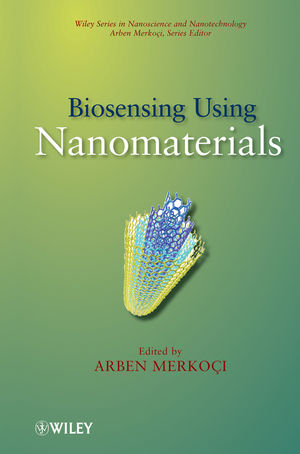Biosensing Using NanomaterialsISBN: 978-0-470-18309-0
Hardcover
520 pages
April 2009
 |
||||||
SERIES PREFACE.
PREFACE.
PART I CARBON NANOTUBES.
1. Carbon Nanotube–Based Sensors and Biosensors (Richard G. Compton, Gregory G. Wildgoose, and Elicia L. S. Wong).
1.1. Introduction to the Structure of Carbon Nanotubes.
1.2. Electroanalysis Using CNT-Modified Electrodes.
1.3. Advantageous Application of CNTs in Sensors: pH Sensing.
1.4. Carbon Nanotube–Based Biosensors.
1.5. Using CNTs in Biosensor Production for Medical Diagnostics and Environmental Applications.
References.
2. Isotropic Display of Biomolecules on CNT-Arrayed Nanostructures (Mark R. Contarino, Gary Withey, and Irwin Chaiken).
2.1. Introduction: CNT Arrays for Biosensing.
2.2. Functionalization of CNTs: Controlling Display Through Covalent Attachment.
2.3. Self-Assembling Interfaces: Anchor-Probe Approach.
2.4. Molecular Wiring of Redox Enzymes.
2.5. Multiplexing Biomolecules on Nanoscale CNT Arrays.
2.6. Conclusions.
References.
3. Interaction of DNA with CNTs: Properties and Prospects for Electronic Sequencing (Sheng Meng and Efthimios Kaxiras).
3.1. Introduction.
3.2. Structural Properties of Combined DNA–CNT Systems.
3.3. Electronic Structure.
3.4. Optical Properties.
3.5. Biosensing and Sequencing of DNA Using CNTs.
3.6. Summary.
References.
PART II NANOPARTICLES.
4. Improved Electrochemistry of Biomolecules Using Nanomaterials (Jianxiu Wang, Andrew J. Wain, Xu Zhu, and Feimeng Zhou).
4.1. Introduction.
4.2. CNT-Based Electrochemical Biosensors.
4.3. Nanoparticle-Based Electrochemical Biosensors.
4.4. Quantum Dot–Based Electrochemical Biosensors.
4.5. Conclusions and Outlook.
References.
5. The Metal Nanoparticle Plasmon Band as a Powerful Tool for Chemo- and Biosensing (Audrey Moores and Pascal Le Floch).
5.1. Introduction.
5.2. The SPB: An Optical Property of Metal NPs.
5.3. Plasmon Band Variation Upon Aggregation of Nanoparticles.
5.4. Plasmon Band Variation on the Environment or Ligand Alteration.
5.5. Metal Nanoparticles as Labels.
5.6. Conclusions.
References.
6. Gold Nanoparticles: A Versatile Label for Affinity Electrochemical Biosensors (Adriano Ambrosi, Alfredo de la Escosura-Mun˜ iz, Maria Teresa Castaneda, and Arben Merkoci).
6.1. Introduction.
6.2. Synthesis of AuNPs.
6.3. Characterization of AuNPs.
6.4. AuNPs as Detecting Labels for Affinity Biosensors.
6.5. Conclusions.
References.
7. Quantum Dots for the Development of Optical Biosensors Based on Fluorescence (W. Russ Algar and Ulrich J. Krull).
7.1. Introduction.
7.2. Quantum Dots.
7.3. Basic Photophysics and Quantum Confinement.
7.4. Quantum Dot Surface Chemistry and Bioconjugation.
7.5. Bioanalytical Applications of Quantum Dots as Fluorescent Labels.
7.6. Fluorescence Resonance Energy Transfer and Quantum Dot Biosensing.
7.7. Summary.
References.
8. Nanoparticle-Based Delivery and Biosensing Systems: An Example (Almudena Mun˜oz Javier, Pablo del Pino, Stefan Kudera, and Wolfgang J. Parak).
8.1. Introduction.
8.2. Functional Colloidal Nanoparticles.
8.3. Polyelectrolyte Capsules as a Functional Carrier System.
8.4. Uptake of Capsules by Cells.
8.5. Delivery and Sensing with Polyelectrolyte Capsules.
8.6. Conclusions.
References.
9. Luminescent Quantum Dot FRET-Based Probes in Cellular and Biological Assays (Lifang Shi, Nitsa Rosenzweig, and Zeev Rosenzweig).
9.1. Introduction.
9.2. Luminescent Quantum Dots.
9.3. Fluorescence Resonance Energy Transfer.
9.4. Quantum Dot FRET-Based Protease Probes.
9.5. Summary and Conclusions.
References.
10. Quantum Dot–Polymer Bead Composites for Biological Sensing Applications (Jonathan M. Behrendt and Andrew J. Sutherland).
10.1. Introduction.
10.2. Quantum Dot–Composite Construction.
10.3. Applications of QD Composites.
10.4. Future Directions.
References.
11. Quantum Dot Applications in Biomolecule Assays (Ying Xu, Pingang He, and Yuzhi Fang).
11.1. Introduction to QDs and Their Applications.
11.2. Preparation of QDs for Conjugation with Biomolecules and Cells.
11.3. Special Optoelectronic Properties in the Bioemployment of
QDs.
11.4. Employment of QDs as Biosensing Indicators.
References.
12. Nanoparticles and Inductively Coupled Plasma Mass Spectroscopy–Based Biosensing (Arben Merkoc¸i, Roza Allabashi, and Alfredo de la Escosura-Muniz).
12.1. ICP-MS and Application Possibilities.
12.2. Detection of Metal Ions.
12.3. Detection of Nanoparticles.
12.4. Analysis of Metal-Containing Biomolecules.
12.5. Bioanalysis Based on Labeling with Metal Nanoparticles.
12.6. Conclusions.
References.
PART III NANOSTRUCTURED SURFACES.
13. Integration Between Template-Based Nanostructured Surfaces and Biosensors (Walter Vastarella, Jan Maly, Mihaela Ilie, and Roberto Pilloton).
13.1. Introduction.
13.2. Nanosphere Lithography.
13.3. Nanoelectrodes Ensemble for Biosensing Devices.
13.4. Concluding Remarks.
References.
14. Nanostructured Affinity Surfaces for MALDI-TOF-MS–Based Protein Profiling and Biomarker Discovery (R. M. Vallant, M. Rainer, M. Najam-Ul-Haq, R. Bakry, C. Petter, N. Heigl, G. K. Bonn, and C. W. Huck).
14.1. Proteomics and Biomarkers.
14.2. MALDI in Theory and Practice.
14.3. Carbon Nanomaterials.
14.4. Near-Infrared Diffuse Reflection Spectroscopy of Carbon Nanomaterials.
References.
PART IV NANOPORES.
15. Biosensing with Nanopores (Ivan Vlassiouk and Sergei Smirnov).
15.1. Nanoporous Materials in Sensing.
15.2. Nanochannel and Nanopore Fabrication.
15.3. Surface Modification Chemistry
15.4. Nonelectrical Nanoporous Biosensors.
15.5. Electrical Nanoporous Biosensors.
15.6. Summary.
References.
INDEX.



